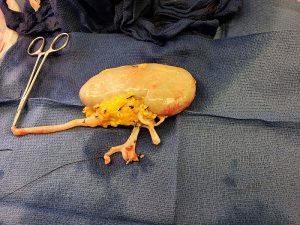
“Reduced Exposure to Calcineurin Inhibitors in Renal Transplantation”
by the Efficacy Limiting Toxicity Elimination (ELITE)-Symphony investigators
N Engl J Med. 2007 Dec 20;357(25):2562-75. [free full text]
—
A maintenance immunosuppressive regimen following kidney transplantation must balance the benefit of immune tolerance of the transplanted kidney against the adverse effects of the immunosuppressive regimen. Calcineurin inhibitors, such as cyclosporine (CsA) and tacrolimus, are nephrotoxic and can cause long-term renal dysfunction. They can also cause neurologic and infectious complications. At the time of this study, tacrolimus had been only recently introduced but already was appearing to be better than CsA at preventing acute rejection. Sirolimus, an mTOR inhibitor, is notable for causing delayed wound healing, among other adverse effects. The goal of the ELITE-Symphony study was to directly compare two different dosing regimens of CsA (standard- and low-dose) versus low-dose tacrolimus versus low-dose sirolimus, all while on background mycophenolate mofetil (MMF) and prednisone in order to determine which of these immunosuppressive regimens had the lowest nephrotoxicity, most efficacious prevention of rejection, and fewest other adverse effects.
The trial enrolled adults aged 18-75 scheduled to receive kidney transplants. There was a detailed set of exclusion criteria, including the need for treatment with immunosuppressants outside of the aforementioned regimens, specific poor prognostic factors regarding the allograft match or donor status, and specific comorbid or past medical conditions of the recipients. Patients were randomized open-label to one of four immunosuppressive treatment regimens in addition to MMF 2 gm daily and corticosteroids (“according to practice at the center” but with a pre-specified taper of minimum maintenance doses): 1) standard-dose CsA (target trough 150-300 ng/mL x3 months, then target trough 100-200 ng/mL), 2) daclizumab induction accompanied by low-dose cyclosporine (target trough 50-100 ng/mL), 3) daclizumab induction accompanied by low-dose tacrolimus (target trough 3-7 ng/mL), and 4) daclizumab induction accompanied by low-dose sirolimus (target trough 4-8 ng/mL). The primary endpoint was the eGFR at 12 months after transplantation. Secondary endpoints included acute rejection, incidence of delayed allograft function, and frequency of treatment failure (defined as use of additional immunosuppressive medication, discontinuation of any study medication for > 14 consecutive days or > 30 cumulative days, allograft loss, or death) within the first 12 months.
1645 patients were randomized. There were no significant differences in baseline characteristics among the four treatment groups. At 12 months following transplantation, mean eGFR differed among the four groups (p < 0.001). Low-dose tacrolimus patients had an eGFR of 65.4 ± 27.0 ml/min while standard-dose cyclosporine patients had an eGFR of 57.1 ± 25.1 ml/min (p < 0.001 for pairwise comparison with tacrolimus), low-dose cyclosporine patients had an eGFR of 59.4 ± 25.1 ml/min (p = 0.001 for pairwise comparison with tacrolimus), and low-dose sirolimus patients had an eGFR of 56.7 ± 26.9 ml/min (p < 0.001 for pairwise comparison with tacrolimus). The incidence of biopsy-proven acute rejection (excluding borderline values) at 6 months was only 11.3% in the low-dose tacrolimus group; however it was 24.0% in the standard-dose cyclosporine, 21.9% in the low-dose cyclosporine, and 35.3% in the low-dose sirolimus (p < 0.001 for each pairwise comparison with tacrolimus). Values were similar in magnitude and proportionality at 12-month follow-up. Delayed allograft function (among recipients of a deceased donor kidney) was lowest in the sirolimus group at 21.1% while it was 35.7% in the low-dose tacrolimus group (p = 0.001), 33.6% in the standard-dose cyclosporine group, and 32.4% (p = 0.73 for pairwise comparison with tacrolimus) in the low-dose cyclosporine group (p = 0.51 for pairwise comparison with tacrolimus). Treatment failure occurred in 12.2% of the low-dose tacrolimus group, 22.8% of the standard-dose cyclosporine group (p < 0.001 for pairwise comparison with tacrolimus), 20.1% of the low-dose cyclosporine group (p = 0.003 for pairwise comparison with tacrolimus), and in 35.8% of the low-dose sirolimus group (p < 0.001 for pairwise comparison with tacrolimus). Regarding safety events, the incidence of new-onset diabetes after transplantation (NODAT) at 12 months was highest among the low-dose tacrolimus group at 10.6% but only 6.4% among the standard-dose cyclosporine group, 4.7% among the low-dose cyclosporine group, and 7.8% among the low-dose sirolimus group (p = 0.02 for between-group difference per log-rank test). Opportunistic infections were most common in the standard-dose cyclosporine group at 33% (p = 0.03 for between-group difference per log-rank test).
In summary, the post-kidney transplant immunosuppression maintenance regimen with low-dose tacrolimus was superior to the standard- and low-dose cyclosporine regimens and sirolimus regimens with respect to renal function at 12 months, acute rejection at 6 and 12 months, and treatment failure during follow-up. However, this improved performance came at the cost of a higher rate of new-onset diabetes after transplantation. The findings of this study were integral to the 2009 KDIGO Clinical Practice Guideline for the Care of Kidney Transplant Recipients which recommends maintenance with a calcineurin inhibitor (tacrolimus first-line), and antiproliferative agent (MMF first-line), and corticosteroids (can consider discontinuation within 1 week in the relatively few patients at low immunologic risk for acute rejection, though expert opinion at UpToDate disagrees with this recommendation).
Further Reading/References:
1. ELITE-Symphony @ Wiki Journal Club
2. “The ELITE & the Rest in Kidney Transplantation.” Renal Fellow Network.
3. “HARMONY: Is it safe to withdraw steroids early after kidney transplant?” NephJC
4. 2009 KDIGO Clinical Practice Guideline for the Care of Kidney Transplant Recipients
5. “Maintenance immunosuppressive therapy in kidney transplantation in adults.” UpToDate
Summary by Duncan F. Moore, MD
Image Credit: Rmarlin, CC BY-SA 4.0, via Wikimedia Commons